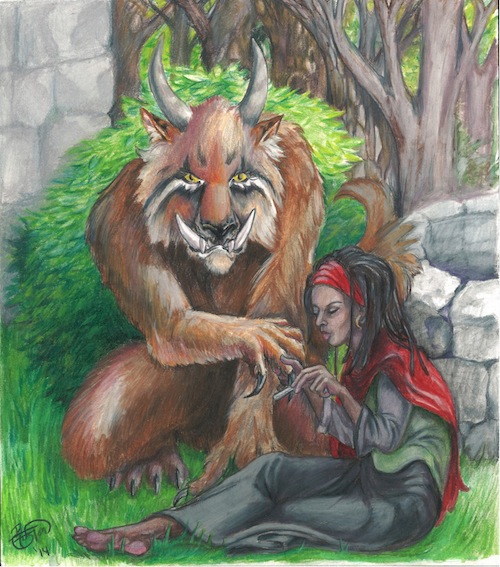Earlier this autumn I was infuriated enough by a bigoted and incompetent review of a talented writer’s work that I decided to review it myself. The result was Rich and Strange, a commitment to review short fiction on a weekly basis, focusing on work in magazines that I’ve especially loved. I reviewed three stories—Sam J. Miller’s “We Are the Cloud,” Alyssa Wong’s “Santos de Sampaguitas,” and Kate Hall’s “The Scrimshaw and the Scream”—before taking Tor.com up on the invitation of running the column here.
Partly in honour of Liz Bourke’s Sleeps With Monsters column but mostly just because it’s dazzling, the first story I want to single out for praise in this venue is C. S. E. Cooney’s “Witch, Beast, Saint: an Erotic Fairy Tale.”
Full disclosure: C. S. E. Cooney is a dear friend, sister-in-arms, and frequent collaborator of mine. But she is all of these things because, first and foremost, I fell in love with her words; it seems only right and proper, therefore, that I should bring them to your attention.
First, absolutely no one writes fairy tales like Cooney. There are deft re-tellers of fairy tale, scholars of it, writers who will re-invent and re-visit and re-build from the bones of old stories something that is of the moment, a pointed comment on our times and on our reading, and I utterly love these: the excellent work of Catherynne Valente, Veronica Schanoes, Rachel Swirsky, Genevieve Valentine come to mind. But what Cooney does is make you feel as if you’re a citizen of fairy tale space, inhabiting the lands and experiencing the stories adjacent to those better-known: Cinderella might be a few towns over, but she doesn’t matter here. Cooney writes new fairy tales with a vigour and velocity that make me remember how I felt on first discovering The Snow Queen in a book too big for my lap.
Vigour and velocity, as it happens, are appropriate keywords for “Witch, Beast, Saint.”
A witch discovers a beast dying in a forest, and takes him home to keep. She can tell right away that he was once a man; she washes and revives him, feeds him, takes care of him, and they become companionable. Soon they become rather more than that; not long afterwards, the arrival of an itinerant saint troubles their romance.
I loved this story chiefly for the witch. All my other loves derive from her. Her voice, her hungers, her frank perspective on the world, her utter contentment with herself and her needs—I adored her sly wit and generosity, her uncomplicated kindness, her fierce vengeance. Also it was shockingly delightful to me to see such a beautiful depiction of enthusiastic consent, kink, and polyamory in a fairy tale setting—no technical terms, no rhetoric, just the cheerful twining of compatible desires in a magical world.
It was also beautiful to see that, in spite of being a story calculated not to pass the Bechdel test (there are no named characters), the witch’s first-person narration teems with women: she thinks about and speaks of her mother, of others witches who preceded her, of witches who’ve succeeded elsewhere and changed their vocations. Even when she isn’t speaking of women, she’s imagining befriending them:
“She said… do you mind if I tell you?” he asked me suddenly. “Only—it will sound like a boast.”
“I generally don’t mind much,” I replied. “Until I need to. Saves energy.”
“She said I was beautiful enough to kiss all the wild things of the wood tame, if I but learned to use my mouth correctly.”
I laughed, leaning back in my chair. I had never met this witch, this beauty, this princess, but I could tell we would’ve been friends.
This is a story of the female gaze and of female desire, and it’s loving and respectful and full of joy. There are betrayals, and disappointment, and longing, but in true romance tradition they resolve themselves into keenest satisfaction. And the writing is so gorgeous; while the bawdiness embraces a self-aware ridiculosity that’s very effective without being satire or parody, the narrative voice is so rich and vibrant and full of colour that you can never doubt the seriousness of feeling underlying it all.
If you enjoy this story and find yourself, as I did, resorting to comment-field fan fiction in order to keep yourself from leaving Cooney’s fairy world too soon, you might be heartened to know that it’s the first in a series of witch-stories: two stand-alone novellas, The Witch in the Almond Tree and The Breaker Queen, are available as ebooks.
Amal El-Mohtar is the author of The Honey Month, a collection of stories and poems written to the taste of 28 different kinds of honey. She has twice received the Rhysling award for best short poem, and her short story “The Green Book” was nominated for a Nebula award. Her work has most recently appeared in Lightspeed magazine’s special “Women Destroy Science Fiction” issue, Kaleidoscope: Diverse YA Science Fiction and Fantasy, and is forthcoming in Uncanny. She also edits Goblin Fruit, an online quarterly dedicated to fantastical poetry. Follow her on Twitter.










